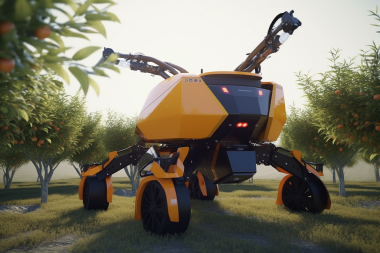Research: Phenotyping takes to the fields
The acquisition of observation data on plants has developed considerably in controlled environments. This is not the case for outdoor phenotyping. The European Phenet project is determined to rise to this challenge. Its ambition is to deploy tools for use in fields and orchards. David Rousseau, a physics professor, member of the Angevin Systems Engineering Research Laboratory (Laris), and founder of the ImHorPhen team within the Horticulture and Seeds Research Institute (IRHS), will be piloting the workgroup on sensors, data processing and artificial intelligence.
Phenotyping involves measuring a set of visible characteristics of a plant. Fruit size, foliage surface and the impact of disease are just some of the characteristics that are examined using imaging techniques. This information is invaluable for understanding the plant's gene expression in a given environment.
Technological advances have led to numerous data acquisition tools being developed. They are mainly used in laboratories or greenhouses. David Rousseau explains that with Phenet, "we are going to extend phenotyping services to questions that arise outdoors, in fields and orchards, to study the plant response to stresses (water, pests, diseases) in the context of climate change".
Sensor-packed robots
 With EU funding until 2027, the Phenet project (Tools and methods for extended plant PHENotyping and EnviroTyping services of European Research Infrastructures) brings together research infrastructures specialising in phenotyping, ecosystem experimentation, long-term observations and bioinformatics in France, Italy, Germany, the Netherlands, etc. It is coordinated by the French National Institute for Agricultural Research (Inrae), and is set to provide services that can be used in situ, drawing on embedded artificial intelligence.
With EU funding until 2027, the Phenet project (Tools and methods for extended plant PHENotyping and EnviroTyping services of European Research Infrastructures) brings together research infrastructures specialising in phenotyping, ecosystem experimentation, long-term observations and bioinformatics in France, Italy, Germany, the Netherlands, etc. It is coordinated by the French National Institute for Agricultural Research (Inrae), and is set to provide services that can be used in situ, drawing on embedded artificial intelligence.
David Rousseau explains: "In practical terms, we will be creating and deploying measurement systems. This will include connected pegs and pheno-mobiles, i.e. stationary or mobile robots equipped with thermal, infrared and colour sensors, etc., to take measurements of both the development of plants and their environment. All of this will be done in line with agroecological farming practices, i.e. practices which optimise the use of natural resources as a production factor while maintaining their capacity for renewal".
The researchers are not starting from scratch. A previous European programme, Invite, "has paved the way by developing prototypes. With Phenet, the goal will be to produce fully operational systems". The project will be carried out in collaboration with companies working in this sector, in particular Hiphen, a young company that has grown out of research work by INRAE.
An innovative microscopy technique
David Rousseau is also involved in another European project, not in the plant sector (not yet), but in the health sector. Entitled IVBM-4PAP (Development of an In-Vivo Brillouin Microscope (with application to Protein Aggregation-based Pathologies)), the project seeks to develop a fast-scanning Brillouin microscope suitable for in-vivo measurements in cells and tissues. The project brings together Italian, French and Spanish researchers, and is led by the inventors of Brillouin microscopy, the Rome-based Fondazione Istituto Italiano di Tecnologia.
As David Rousseau, who is in charge of data processing and artificial intelligence, explains, this new technique "enables the mechanical properties of samples (elasticity, rigidity) to be probed at the cellular level, without contact." With a physicist from the Moltech-Anjou research laboratory (Matthieu Loumaigne) and Guillaume Mabilleau's Regos-Rmes research team, which studies the pathophysiology and ageing of bone tissue, "we will be working on pathological and healthy bone samples. The ultimate goal is to provide a faster, more accurate diagnosis than is currently possible." This project is at the feasibility stage of the technique.
